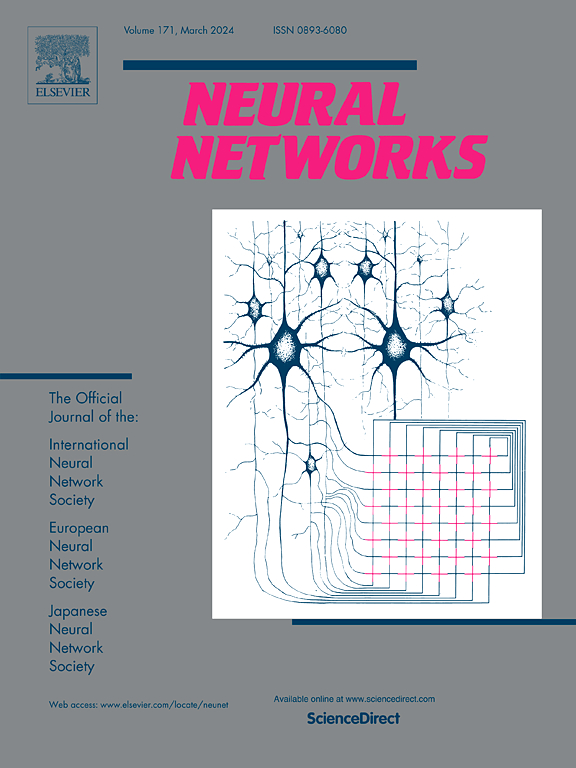Open-set long-tailed recognition via orthogonal prototype learning and false rejection correction
IF 6
1区 计算机科学
Q1 COMPUTER SCIENCE, ARTIFICIAL INTELLIGENCE
引用次数: 0
Abstract
Learning from data with long-tailed and open-ended distributions is highly challenging. In this work, we propose OLPR, which is a new dual-stream Open-set Long-tailed recognition framework based on orthogonal Prototype learning and false Rejection correction. It consists of a Probabilistic Prediction Learning (PPL) branch and a Distance Metric Learning (DML) branch. The former is used to generate prediction probability for image classification. The latter learns orthogonal prototypes for each class by computing three distance losses, which are the orthogonal prototype loss among all the prototypes, the balanced Softmin distance based cross-entropy loss between each prototype and its corresponding input sample, and the adversarial loss for making the open-set space more compact. Furthermore, for open-set learning, instead of merely relying on binary decisions, we propose an Iterative Clustering Module (ICM) to categorize similar open-set samples and correct the false rejected closed-set samples simultaneously. If a sample is detected as a false rejection, i.e., a sample of the known classes is incorrectly identified as belonging to the unknown classes, we will re-classify the sample to the closest known/closed-set class. We conduct extensive experiments on ImageNet-LT, Places-LT, CIFAR-10/100-LT benchmark datasets, as well as a new long-tailed open-ended dataset that we build. Experimental results demonstrate that OLPR improves over the best competitors by up to 2.2% in terms of overall classification accuracy in closed-set settings, and up to 4% in terms of F-measure in open-set settings, which are very remarkable.
通过正交原型学习和错误拒绝校正实现开放集长尾识别
从长尾分布和开放分布的数据中学习是一项极具挑战性的工作。在这项工作中,我们提出了 OLPR,这是一种基于正交原型学习和错误拒绝校正的新型双流开放集长尾识别框架。它由概率预测学习(PPL)分支和距离度量学习(DML)分支组成。前者用于生成图像分类的预测概率。后者通过计算三种距离损失来学习每个类别的正交原型,即所有原型之间的正交原型损失、每个原型与其相应输入样本之间基于软敏距离的平衡交叉熵损失,以及使开集空间更紧凑的对抗损失。此外,对于开放集学习,我们不再仅仅依赖二元判定,而是提出了一个迭代聚类模块(ICM),用于对相似的开放集样本进行分类,并同时纠正被错误剔除的封闭集样本。如果检测到一个样本被错误拒绝,即已知类别的样本被错误地识别为属于未知类别,我们将把该样本重新分类到最接近的已知/封闭集类别。我们在 ImageNet-LT、Places-LT、CIFAR-10/100-LT 基准数据集以及我们建立的新的长尾开放式数据集上进行了广泛的实验。实验结果表明,在封闭集环境下,OLPR 的整体分类准确率比最佳竞争者提高了 2.2%,在开放集环境下,OLPR 的 F-measure 提高了 4%,这是非常了不起的。
本文章由计算机程序翻译,如有差异,请以英文原文为准。
求助全文
约1分钟内获得全文
求助全文
来源期刊

Neural Networks
工程技术-计算机:人工智能
CiteScore
13.90
自引率
7.70%
发文量
425
审稿时长
67 days
期刊介绍:
Neural Networks is a platform that aims to foster an international community of scholars and practitioners interested in neural networks, deep learning, and other approaches to artificial intelligence and machine learning. Our journal invites submissions covering various aspects of neural networks research, from computational neuroscience and cognitive modeling to mathematical analyses and engineering applications. By providing a forum for interdisciplinary discussions between biology and technology, we aim to encourage the development of biologically-inspired artificial intelligence.
 求助内容:
求助内容: 应助结果提醒方式:
应助结果提醒方式:


